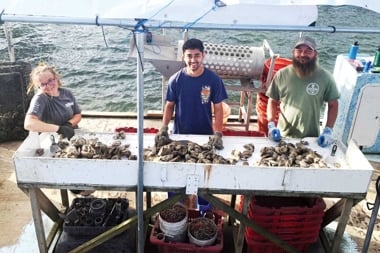Growing Winter Greens
Long before the first crops are available from local farms and gardens, many people are longing for fresh produce and it's possible, even in the depths of winter--right from your own kitchen counter! Sprouts..
Long before the first crops are available from local farms and gardens, many people are longing for fresh produce and it's possible, even in the depths of winter right from your own kitchen counter! Sprouts.
Most people first encounter sprouts in their local vegetarian restaurant's veggie burger or green salad. However, they're becoming more widely used even in the most conventional of kitchens. In Canada, we're fortunate to have not only organic farms dedicated to producing sprouting seeds, but a number of well-established and highly reputable companies specializing in sprouts. Eating sprouts is not just a good way to support local growers, it's also an excellent source of many nutrients.
When a seed is sprouted, it intensifies the nutrients of that particular food in a neat little package. The sprouting process breaks down the starch into simple sugars, the fat into free fatty acids and the protein into amino acids and peptones. The nutrients are thus essentially predigested and therefore more easily assimilated and metabolized.
The sprouting process also dramatically increases the seeds' vitamins and enzymes. For example, sprouted wheat and millet contain more than five times the vitamin C than when not sprouted. Fenugreek seeds are rich in iron, lentils in protein and sunflower sprouts are rich in minerals. Sprouts supply antioxidants, high quality protein, fibre, vitamins A, C, B and E as well as phosphorus, zinc, potassium and precious trace elements.
Kitchen Garden
With very little cost and effort, you can become a home-scale sprout farmer with the addition of a simple, new kitchen routine. First there are some basics to sprouting that everyone needs to know: you don't have to buy special pre-packaged sprouting seeds and kits. Where genetic engineering has not tampered with mother nature, virtually all fresh seeds will sprout, given anything remotely resembling ideal conditions. So most whole seeds (which, for the purposes of this article, includes grains and legumes) in the organic bulk section of your favourite health food store will sprout. Many conventional seeds will have been fumigated or irradiated, and while this kills off the bugs people don't like to see in their food, it also kills the seed. (Do not try to sprout garden seeds, especially those of the nightshade family. They are toxic.) To sprout the seeds, you can grow them in a glass jar, an untreated (bamboo) basket or a linen or hemp cloth bag with a drawstring.
Baskets and Bags Make it Easier
After years of sprouting in jars and not always being adequately disciplined to keep them from going slimy, I am a firm believer in baskets and bags. It's a simple and almost foolhardy way of growing sprouts. The method is the same for jar, bag or basket: you start by soaking the seeds for anywhere from four to 12 hours. Then you put them in the chosen receptacle and rinse them a couple of times a day. Somewhere between days four and seven you will have a garden to harvest on your own kitchen counter!
If you are using a basket, find one which has not been shellacked and which has sidewalls. The weave of the basket must be tight enough to keep the chosen seeds from falling through but not so tight that the basket cannot "breathe." Place the basket in boiling water for three minutes to disinfect it. After the initial soaking of the seeds, drain them and spread them evenly across the bottom of the basket. Place the basket over something that doesn't mind getting damp and create a mini greenhouse by covering it with a clear plastic box, such as the ones used for packaging baked goods. In the morning and evening, place the basket in a bowl of water and let it rest there for 30 seconds or so. Remove the basket and tilt it to let the water drain out. Then return it to its greenhouse. A tablespoon of alfalfa seeds will fill a three inch basket with lush green sprouts. When they are ready for eating they can be gently pulled from the basket and eaten.
The advantage of sprouting in a bag is that they are very portable and can be taken camping or on bicycling trips. Though the bags are not readily purchased, they are easily made. They need to be of linen or hemp because the fibres won't expand when wet, allowing the sprouts to still get air.
The weave of the fabric should be loose, almost like needle-point fabric. Fifteen centimetres long by 25 cm wide is a good size. After soaking the seeds, simply dump them into the bag, rinse them, tighten the drawstring and then hang it over your sink or dish rack so it can drip. Soak the bag in a bowl of water as often as it begins to feel dry. In the winter this will be more often. Towards the end of the growing period for the sprouts, leave the drawstring loose so that the tiny leaves can develop chlorophyll.
Some Extra Tips
You can use food grade hydrogen peroxide in the soaking water to give the seeds an extra dose of oxygen and to cleanse the seeds (one-half teaspoon in two cups water). Most sprouts are best eaten raw, though some of the larger legume sprouts can be added to soups and stews. Once your sprouts are ready store them in their sprouting container in the fridge generally for up to as long as it took them to sprout. And don't be alarmed when your basket and bag start to discolour this is from the natural dyes present in the seed hulls.
Sprouting is an adventure. But remember, these babies need nurturing. Keep them warm, don't neglect them and enjoy them when they're green and fresh. They're the best winter food there is.




